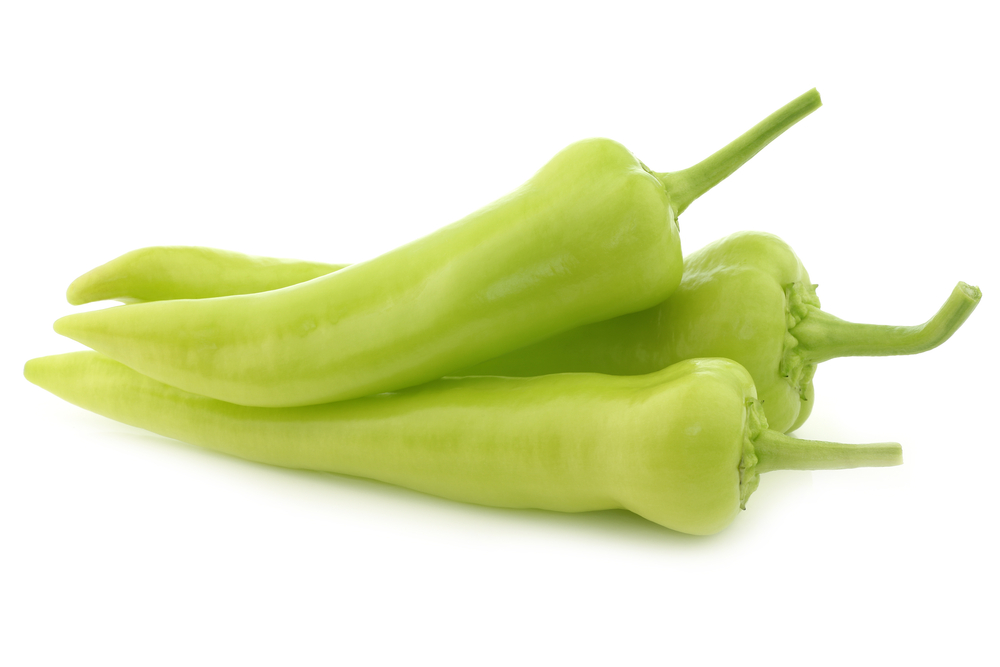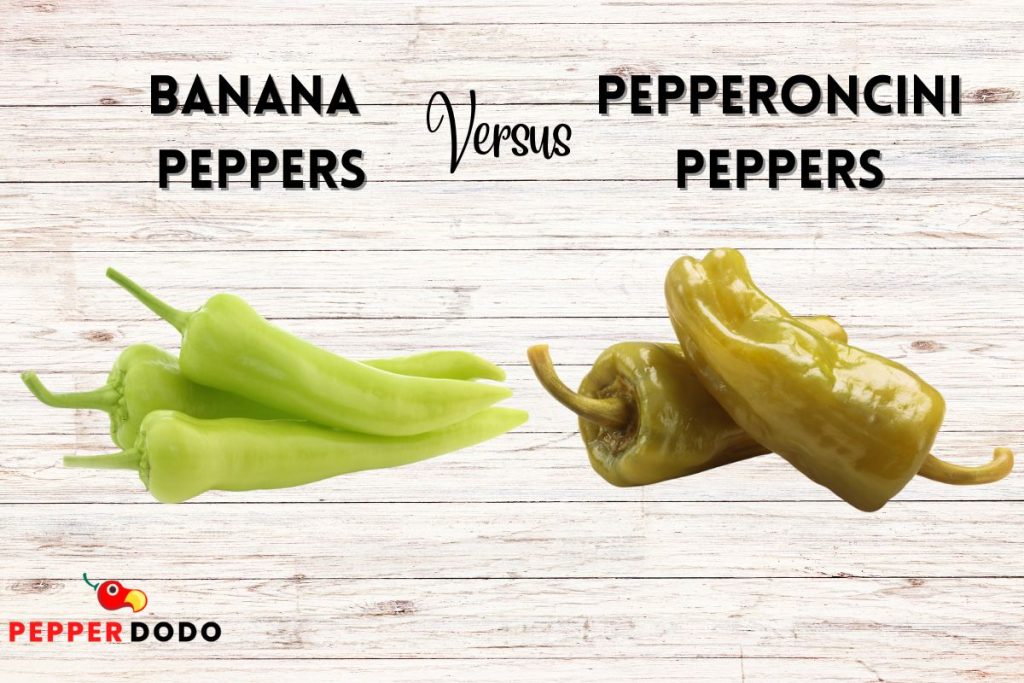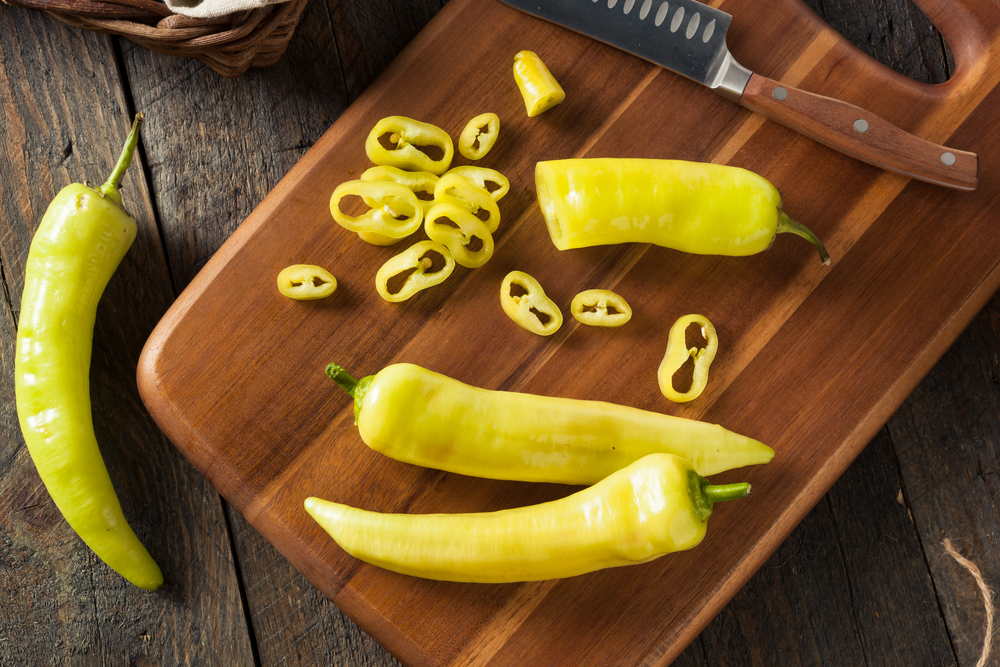Banana peppers are often confused with pepperoncinis, but they are two different peppers. Considered a very mild, almost sweet pepper, banana peppers have a tangy flavor and crunch, making them perfect fresh or pickled on salads, sandwiches, and pizza.
What Are Banana Peppers?
Banana peppers are mild, medium-sized chili peppers with an elongated shape that resembles a banana.

Banana peppers are bright yellow at harvesting but turn green, orange, or red when fully ripened. The color of the peppers can be greenish-yellow, all yellow, orange, or red at full maturity.
Like other peppers, the sweetness of banana peppers improves with maturity as the pods are allowed to stay longer on the plant and grow to full ripening.
Banana peppers botanically belong to the Capsicum annuum species and are rich in vitamin A and vitamin C. The peppers are rich in vitamins B1, B2, B3, and B9. They are also an excellent source of iron, phosphorous, fiber, potassium, and manganese.
Are Banana Peppers Hot Or Sweet?
Banana peppers clock 0-500 SHUs (Scoville Heat Units), meaning they are mild peppers bordering on sweetness rather than hotness. They are more notable for their subtle tangy flavor.
A 500-SHU sweet banana pepper is five times milder than a 2,500-SHU jalapeno, while one with 0 SHUs has the same sweetness as bell peppers.
Pepperoncini Vs. Banana Pepper
Banana peppers and pepperoncini are not the same. The two peppers are usually confused because of their color, shape, and uses in cooking.
Pepperoncini are Italian peppers and are more common in Greek cuisine. Banana peppers are native to South America.
Although they both max out at 500 SHUs, pepperoncini and banana peppers have slightly different flavors. Both peppers are sweet, but pepperoncini have a lingering subtle bitterness and fiery flavor, while some banana peppers register zero heat.
The difference in flavor between the two peppers is negligible when they are pickled but more apparent when eaten raw.
Pepperoncini peppers are slightly greener than fresh banana peppers, which are usually fully yellow or greenish-yellow. Pepperoncini’s texture is also wrinkly, while banana peppers have smooth skin.
Banana peppers have a pointier end, while pepperoncini peppers have a blunt, rounded end.

You will also find banana peppers confused with Hungarian wax peppers, which also have a banana-like shape and are harvested when still yellow right before maturity. However, Hungarian wax peppers are significantly spicier, coming in at 1,000-15,000 SHUs!
What’s Another Name For Banana Peppers?
Banana peppers are also called banana chile peppers, yellow wax peppers, banana chilis, or sweet frying peppers.
How Are Banana Peppers Used?
You can use banana peppers fresh, raw, pickled, grilled, roasted, or baked. Pepper rings and pickled peppers are more readily available than the other forms.
Banana peppers are used in the following ways:
- Stuffed raw with rice, spices, cream cheese, corn, quinoa, salsa, or ground beef. Stuffed peppers can be baked, grilled, pan-seared, or fried.
- Added to stews and soups for a tangy taste.
- Sauteed with Italian sausage and red onions as a hoagie filling.
- Sliced into rings and used as a topping for pizza, sandwiches, salads, nachos, tacos, and toasts.
- Pickled and used in all the same ways as above, especially when added to Italian subs with salami!
- Cooked and pureed in mild banana pepper hot sauces.
- Chopped in banana pepper salsas and relishes, which makes the salsa sweeter. These are delicious with nachos or as a topping for hot dogs.
- Deep-fried and eaten as a side for fried chicken, ham, or barbecue.
- As a substitute for pepperoncini and bell peppers for flavor, and Hungarian wax peppers or serrano peppers if you need to scale down the heat to a mild level.
Here are some banana pepper recipes you can try:
- Bob’s stuffed banana peppers
- Pickled banana peppers
- Stuffed banana peppers (courtesy of Food Network)
- Banana pepper rings (courtesy of Food.com)
Can You Grow Banana Peppers?
You can grow your own banana peppers in containers or directly in the ground in warm weather.
Like other peppers, banana peppers do well in well-drained soils and warm climates. They require plenty of sunlight for up to eight hours daily.
Banana pepper seeds bought online can be planted in pots or containers and grown indoors for two months before being transplanted outdoors.
Your containers should be at least six inches deep to allow proper root penetration within the loose, well-watered soil.
Each pepper plant bears 25-30 peppers, which you can pick when bright yellow or yellow-green. You could also wait for the pods to ripen until red or orange for extra sweetness.

